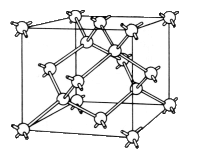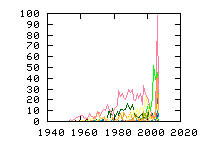« Previous
1
Next »
(18 hits, 1/1)
Showing
10, 25, 50, 100, 500, 1000, all papers per page.
Sort by:
last publication date,
older publication date,
last update date.
- 1. Appl. Phys. Lett. 91, 122109 (2007) , “Determining the defect parameters of the deep aluminum-related defect center in silicon”, Philipp Rosenits, Thomas Roth, Stefan W. Glunz, and Svetlana BeljakowaThrough a combined application of two characterization methods, deep-level transient spectroscopy and lifetime spectroscopy, the lifetime-limiting defect level in intentionally aluminum-contaminated Czochralski silicon has been analyzed and a complete set of defect parameters could be obtained. This... (Read more)
- 2. Phys. Rev. B 75, 045211 (2007) , “Ab initio supercell calculations on aluminum-related defects in SiC”, A. Gali, T. Hornos, N. T. Son, E. Janzén, and W. J. ChoykeAb initio supercell calculations of the binding energies predict complex formation between aluminum and carbon interstitials in SiC. In high-energy implanted SiC aluminum acceptor can form very stable complexes with two carbon interstitials. We also show that carbon vacancy can be attached to... (Read more)
- 3. Appl. Phys. Lett. 89, 092107 (2006) , “Photoluminescence studies of impurity transitions in AlGaN alloys”, N. Nepal, M. L. Nakarmi, J. Y. Lin, and H. X. JiangDeep ultraviolet photoluminescence (PL) spectroscopy has been employed to investigate impurity transitions in Si doped Al-rich AlGaN alloys. In addition to the previously reported donor compensating centers—isolated cation vacancy with three negative charges... (Read more)
- 4. Appl. Phys. Lett. 88, 182903 (2006) , “Effects of Al addition on the native defects in hafnia”, Q. Li, K. M. Koo, W. M. Lau, P. F. Lee, J. Y. Dai, Z. F. Hou, X. G. GongTwo occupied native defect bands are experimentally detected in pure HfO2. The density of states of band one in the middle of the band gap reduces drastically with the Al addition, while that of band two slightly above the valence-band maximum remains rather unaffected. We attribute the... (Read more)
- 5. Mater. Sci. Eng. C 25, 614-617 (2005) , “Incorporation of cobalt into ZnO nanoclusters”, Igor Ozerov, Françoise Chabre and Wladimir MarineThe structural, optical and magnetic properties of nanostructured ZnO films co-doped with cobalt and aluminium have been studied. The nanocrystalline films, with cluster sizes in range 50–100 nm, were deposited by pulsed laser ablation in a mixed atmosphere of oxygen and helium. The... (Read more)
- 6. Phys. Rev. B 71, 035213 (2005) , “Possibility for the electrical activation of the carbon antisite by hydrogen in SiC”, A. Gali, P. Deák, N. T. Son, and E. JanzénCalculations predict the carbon antisite to be the most abundant intrinsic defect in silicon carbide in a wide range of doping. The isolated carbon antisite is, however, optically and electronically inactive, therefore, difficult to observe by usual experimental techniques. However, CSi... (Read more)
- 7. Phys. Rev. B 69, 233202 (2004) , “Diffusion of hydrogen in perfect, p-type doped, and radiation-damaged 4H-SiC”, B. Aradi, P. De?k, A. Gali, N. T. Son, E. Janz?nThe diffusion of interstitial atomic hydrogen in 4H-SiC was investigated theoretically, using the local density approximation of density functional theory. We have found that the diffusion barrier in the perfect crystal is 0.6 eV. Comparing this value with the calculated zero point vibration... (Read more)
- 8. Phys. Rev. B 63, 165204 (2001) , “g values of effective mass donors in AlxGa1-xN alloys”, M. W. Bayerl, M. S. Brandt, T. Graf, O. Ambacher, J. A. Majewski, M. Stutzmann, D. J. As, K. LischkaElectron spin resonance experiments were performed on Si-doped wurtzite and zinc-blende GaN and Si-doped wurtzite AlxGa1-xN alloys with x=0.15, 0.32, 0.52, 0.75, and 1. For zinc-blende GaN, an isotropic g factor of 1.9475 is found. The g tensors of the silicon effective mass... (Read more)
- 9. Physica B 302-303, 249-256 (2001) , “Hydrogen-Enhanced Clusterization of Intrinsic Defects and Impurities in Silicon”, B. N. Mukashev, Kh. A. Abdullin, Yu. V. Gorelkinskii, M. F. Tamendarov and S. Zh. TokmoldinFormation of intrinsic and impurity defect complexes in hydrogenated monocrystalline silicon is studied. Hydrogen was incorporated into samples by different ways: either by proton implantation at 80 and 300 K, or by annealing at 1250°C for 30–60 min in a sealed quartz ampoule containing... (Read more)
- 10. Jpn. J. Appl. Phys. 38, L113 (1999) , “Yellow Emission from Zinc Oxide giving an Electron Spin Resonance Signal at g=1.96”, Naoki Ohashi, Tomokazu Nakata, Takashi Sekiguchi, Hideo Hosono, Masafumi Mizuguchi, Takaaki Tsurumi, Junzo Tanaka, Hajime HanedaZnO polycrystals doped with Li, Cu or Al were prepared by solid-state reactions and their cathodoluminescence (CL) and electron spin resonance (ESR) spectra were measured. A strong yellow emission centered at 2.0 eV was observed for the Al-doped specimen and its intensity was higher than that of... (Read more)
- 11. Mater. Sci. Eng. B 58, 171-178 (1999) , “Self-Interstitial Related Reactions in Silicon Irradiated by Light Ions”, B. N. Mukashev, Kh. A. Abdullin, Yu. V. Gorelkinskii and S. Zh. TokmoldinRecent deep level transient spectroscopy (DLTS), electron paramagnetic resonance (EPR) and infrared (IR) spectroscopy data on interactions of self-interstitial with carbon, aluminium, oxygen and hydrogen in silicon irradiated by light ions are reviewed. Self-interstitial behaviour in silicon was... (Read more)
- 12. phys. stat. sol. (a) 168, 73 (1998) , “Self-Interstitials in Silicon Irradiated with Light Ions”, B. N. Mukashev, Kh. A. Abdullin, Yu. V. Gorelkinskii.The behavior of self-interstitials in silicon which was irradiated with light ions (protons and -particles) and electrons was explored by monitoring known impurity interstitial centers (Ci, Ali, (Si-O)i) with deep level transient spectroscopy (DLTS) and electron... (Read more)
- 13. phys. stat. sol. (a) 162, 95-151 (1997) , “EPR and ENDOR Investigations of Shallow Impurities in SiC Polytypes”, S. Greulich-WeberInvestigations of nitrogen donors in 6H-, 4H- and 3C-SiC using conventional electron paramagnetic resonance (EPR), electron nuclear double resonance (ENDOR) and optical detection of EPR and ENDOR as well as optical absorption and emission spectroscopy are reviewed and critically discussed. An... (Read more)
- 14. phys. stat. sol. (a) 86, 313 (1984) , “New EPR Defects in Si<Al>”, A. V. Dvurechenskii, B. P. Kashnikov, V. V. Suprunchik.Two new paramagnetic centres, labeled Si-H5 and Si-H6 are found in silicon containing aluminium (6 × 1017 to 5 × 1018 cm-3) and irradiated with high dose of 1 Me V electrons (up to 2 × 1020 cm-2). Spin-Hamiltonian constants of the Si-H5... (Read more)
- 15. Phys. Rev. B 1, 1908 (1970) , “Electron Paramagnetic Resonance of the Aluminum interstitial in Silicon”, Keith L. BrowerElectron-paramagnetic-resonance spectra of the Al++ interstitial (Si-G18) produced in aluminum-doped (p-type) silicon by room temperature or 4?K electron irradiations are presented and show that the Al++ is located in the tetrahedral interstitial site. The hyperfine... (Read more)
- 16. Phys. Rev. 155, 802 (1967) , “Defects in Irradiated Silicon: Electron Paramagnetic Resonance and Electron-Nuclear Double Resonance of the Aluminum-Vacancy Pair”, G. D. Watkins.An EPR spectrum produced in aluminum-doped silicon by 1.5-MeV electron irradiation is described. Labeled Si G9, it is identified as arising from an aluminum-vacancy pair, presumably formed when a mobile lattice vacancy is trapped by substitutional aluminum. The resonance is observed only upon... (Read more)
- 17. Radiation Damage in Semiconductors 97-113 (1965) , Dunod, Paris , “A Review of EPR Studies in Irradiated Silicon”, G. D. Watkins.1. INTRODUCTION (p.97): 2. THE EPR EXPERIMENT (p.97): 3. RESULTS (p.99): A. The lattice Vacancy (p.99), B. Vacancies Trapped by Other Defects (p.102), C. Vacancy Motion (p.103), D. Interstitial Defects (p.103), E. Other Spectra (p.105), 4. SUMMARY AND CONCLUSION (p.110): 5.ACKNOWLEDGMENTS (p.110):
- 18. Solid State Physics 5, 258-319 (1957) , Academic Press, New York (Edited by F. Seitz, D. Turnbull) , “Shallow Impurity States in Silicon and Germanium”, W. KohnI. Introduction (p.258): II. Emprical Properties (p.261): 1. Energy Levels (p.261), a. Ionization Energies, b. Spectra of Excited States, 2. Spin Resonance (p.266), a. Electron Spin Resonance, b. Double Resonance, 3. Static Magnetic Susceptibility (p.271), III. Structure of Donor States (p.271): 4. Conduction Bands of Silicon and Germanium (p.271), a. Silicon, b. Germanium, 5. Effective Mass Theory of Donor States (p.274), a. Single Band Minimum at k=0, b. Several Conduction Band Minima, c. Matrix Elements for Radiative Transitions, 6. Numerical Results and Comparison with Experiments (p.285), a. Energy Levels, b. Wave Functions, 7. Corrections to the Effective Mass Formalism (p.289), a. General Considerations, b. Corrected Wave Functions, c. Comparison with Experiment, IV. Structure of Acceptor States (p.297): 8. Valence Bands of Silicon and Germanium (p.297), a. Silicon, b. Germanium, 9. Effective Mass Equations for Acceptor States (p.300), 10. Approximate Solutions and Comparison with Experiment (p.301) a. Germanium b. Silicon V.Effects of Strains and of Static Electric and Magnetic Fields (p.306): 11. Strains (p.306) a. Donor States, b. Acceptor States, 12. Stark Effect (p.311)
« Previous
1
Next »
(18 hits, 1/1)
Showing
10, 25, 50, 100, 500, 1000, all papers per page.
Sort by:
last publication date,
older publication date,
last update date.
All papers (3399)
Updated at 2010-07-20 16:50:39
Updated at 2010-07-20 16:50:39
(view as: tree
,
cloud
)
| 1329 | untagged |
Materials
(111 tags)
Others(101 tags)
Technique
(46 tags)
Details
(591 tags)
Bond(35 tags)
Defect(interstitial)(18 tags)
Defect(vacancy)(15 tags)
Defect-type(19 tags)
Element(65 tags)
Energy(8 tags)
Isotope(56 tags)
Label(303 tags)
Sample(17 tags)
Spin(8 tags)
Symmetry(15 tags)

